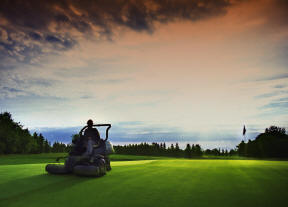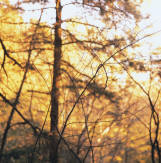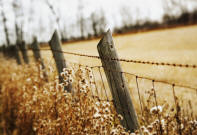|
Fertilizing Lawns
You bought a new house in the
fall. Winter came and went and now itís time to haul out the
lawn mower. As youíre doing laps in the yard, you canít help
but notice all the interesting patches
of pseudo-grass.
You have crabgrass; you have weeds; you have
clover; you have a boatload of dandelions. Contrarily, your
neighborís yard looks like a golf course.

|
Sometimes you'd like to sneak over there without shoes just to
run your feet through the lush greenery. No worries; you can
turn your less than attractive excuse for grass around in one
season; and it wonít cost you a fortune.
Put the
yellow pages away, youíre not calling a service. If you
fertilize at the right time of the year, you can have your own
gorgeous thick green grass.
Many new lawn aficionados are
under the false impression that
spring is the best time to fertilize their grass. Actually,
fertilizing at that time may be detrimental to the long-term
health of the lawn.
Sure youíll get expedited top growth and a
beautiful lush appearance, but at what cost? Spring fertilization
discourages grass from storing food reserves for the hard times
to come during the summer.
Letís jump right to the point. The optimum time to fertilize your lawn
is in the fall. The time of year when most people are
considering putting away their lawn mower, is when you should be
getting out the spreader.
 Itís also the time of year when you can get an accurate picture of
your lawnís health. After the summer stresses, you will be able to
see where the dead brown grass is and where the crabgrass is.| Itís also the time of year when you can get an accurate picture of
your lawnís health. After the summer stresses, you will be able to
see where the dead brown grass is and where the crabgrass is.|
Changes in lawn appearance in October can reveal whether
appropriate lawn care is being
practiced.
Properly fertilized lawns tend to improve in
appearance, while the opposite takes place for improperly
fertilized lawns.
A November application is ideal. Although the air temperatures
will have cooled considerably by this time, soil temperatures
will remain warm enough for some primarily-root and tiller-grass
growth. This late fall fertilization facilitates winterizing the
grass and sets the foundation for the grass to make a quick start
in the spring.
Be prepared that fertilizing at this
late date can result in an additional mowing. However, the
payback is that the grass will have a dark green color going into
winter that returns early in the spring.
Not only does early Spring
fertilization discourage storage of food reserves, the lush top
growth also provides an environment conducive for diseases to
take hold and sweep through a yard.
Therefore, when summer comes,
the spring-only fertilized lawns are often more susceptible to
the summer stresses of disease and moisture stress. Not exactly
the look you were going for.
 The irony of lawn care is that at the end of August when the The irony of lawn care is that at the end of August when the
appearance of oneís lawn hits an all time season low, it is
actually the best time to fertilize or renovate a lawn. By then
grasses have endured the summer stresses and the coming cool fall
temperatures will provide an opportunity for recovery.
Fertilizing in the fall also encourages the plantís recovery by
providing nutrients when the plant really needs them to build
food reserves going into the winter. As a rule of thumb, Labor
Day weekend is a good time to make the first fall fertilization
to lawns, as the cool temperatures are soon to come.
Though it may be spring and youíre envious of your neighborís
yard, donít try to take a short cut and apply a boatload of
fertilizer just to jump start your lawn. Ignore your seasonal
urges and follow responsible soil management practices. Just do
it. Then start fresh this fall. This time next year, youíll be
the envy of your neighbor on the other side!
Share with
your Gardening Friends if you Like This
|
 |
If
you'd like to obtain a great lawn, without breaking your back every
weekend, without spending a fortune and without poisoning your kids,
then this letter about the legendary John Perez could be the
most
important letter on beautifying your lawn you'll ever read.
ALL of John's Recipes are available in a multimedia ebook titled: "Forceful
Insecticides & Fertilizers: Homemade Recipes" Read Letter
for more details |
|
|
|